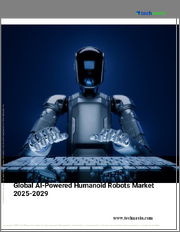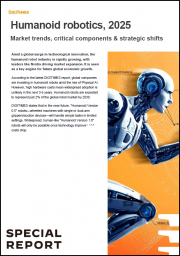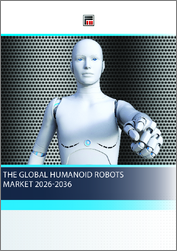
|
시장보고서
상품코드
1715403
휴머노이드 로봇 시장 : 모션 유형, 컴포넌트, 애플리케이션별 - 세계 예측(2025-2030년)Humanoid Robot Market by Motion Type, Component, Application - Global Forecast 2025-2030 |
||||||
휴머노이드 로봇 시장의 2023년 시장 규모는 23억 8,000만 달러로, 2024년에는 30억 6,000만 달러, CAGR 29.77%로 성장하며, 2030년에는 147억 5,000만 달러에 달할 것으로 예측됩니다.
| 주요 시장 통계 | |
|---|---|
| 기준연도 2023 | 23억 8,000만 달러 |
| 추정연도 2024 | 30억 6,000만 달러 |
| 예측연도 2030 | 147억 5,000만 달러 |
| CAGR(%) | 29.77% |
최근 수년간 로봇 공학의 진화는 기술 혁신과 산업 혁신의 중심 무대가 되고 있습니다. 인간의 특징과 기능을 모방한 휴머노이드 로봇은 이제 첨단 역학, 인공지능, 첨단 센서 기술의 합류점에 서 있습니다. 이 진화하는 생태계의 원동력은 계산 능력의 비약적인 향상과 로봇이 자율성과 정확성을 높여 작업을 수행할 수 있도록 하는 알고리즘 능력의 급속한 발전입니다.
인류의 로봇 공학 여정의 현재 단계는 다용도성, 적응성, 안전성에 대한 요구가 증가하고 있는 것으로 정의할 수 있습니다. 오늘날의 의사결정자들은 산업 자동화에서 개인 관리, 교육, 연구, 우주 탐사에 이르기까지 다양한 분야에서 휴머노이드 로봇을 도입할 수 있는 가능성을 인식하고 있습니다. 이 입문적인 개요에서는 이러한 개발이 프로세스, 노동력 역학 및 국제 경쟁력에 미치는 영향을 살펴봅니다. 이제 시장은 단순한 기술 부품의 집합체가 아니라 인간과 로봇의 상호 작용과 작업 효율성에 대한 우리의 이해를 재정의하는 활기찬 산업 생태계가 되었습니다.
센서 기술, 제어 시스템, 재료 공학의 발전으로 보다 자연스럽게 환경과 상호작용할 수 있는 로봇의 개발이 가능해졌습니다. 기능과 형태 모두에 초점을 맞춘 이 기계들은 인간과 기계 사이의 간극을 메우고 있습니다. 산업계가 자동화 능력의 향상에 적응하는 가운데, 휴머노이드 로봇의 도입은 전략적 필수 사항일 뿐만 아니라, 여러 부문의 성장과 혁신을 가속화하는 변화의 촉매제임이 입증되고 있습니다.
휴머노이드 로봇 시장의 변화
급속한 기술 발전은 휴머노이드 로봇을 둘러싼 환경에 변화를 가져오고 있습니다. 인공지능과 머신러닝의 혁신적인 연구개발은 로봇이 환경으로부터 학습하고 실시간으로 적응할 수 있도록 하여 새로운 기능을 촉매하고 있습니다. 이러한 역동적인 기능으로의 전환은 로봇이 더 이상 반복적인 작업에 머물지 않고 점점 더 복잡한 업무 역할을 맡게 되는 시대를 앞당기고 있습니다.
이러한 변화의 큰 원동력은 첨단 센서와 정교한 동작 메커니즘의 통합입니다. 디지털 액추에이터의 개발과 제어 시스템의 개선으로 휴머노이드 로봇은 고정밀하고 효율적인 움직임을 실현할 수 있게 되었습니다. 산업계에서는 지능형 시스템이 인간의 의사결정과 조작 정확도를 확장함으로써 인간 작업자와 로봇의 협업 작업이 활발해지고 있습니다.
또한 소프트웨어 기술의 발전으로 예지보전 및 성능 최적화에 필수적인 강력한 데이터 분석이 가능해졌습니다. 디지털 구성 요소와 기계 구성 요소의 융합은 성능 기준을 강화하고 알고리즘을 스마트화할 수 있는 기반을 마련했습니다. 이러한 기술적 혁신은 유연한 제조, 인간 중심적 관리, 적응형 학습 환경의 길을 열어 시장 패러다임을 재편하고 로봇 분야의 장기적인 전략 수립에 영향을 미치고 있습니다.
요약하면, 하드웨어와 소프트웨어 기술의 진화는 전통적인 기계론적 설계에서 첨단 양방향성, 인지 기능, 멀티모달 기능을 특징으로 하는 시스템으로 종합적인 전환을 보여주고 있습니다. 이러한 융합은 업무 생산성을 향상시킬 뿐만 아니라, 산업 발전의 새로운 길을 열어 혁신이 현상에 도전할 수 있는 생태계를 조성할 것입니다.
심층 분석을 통해 알아보는 주요 세분화 인사이트
휴머노이드 로봇 시장의 굴절된 복잡성은 시장 동향과 성장 궤도에 대한 깊은 인사이트를 제공하는 상세한 세분화 분석을 통해 더욱 명확해집니다. 시장은 모션 유형, 구성 요소 구성, 애플리케이션 부문에 대한 인사이트을 포함한 다차원적 렌즈를 통해 조사됩니다. 주목할 만한 점은 모션 연구 결과, 인간의 보행과 유사한 보행 동역학을 모방하는 이족보행 구성과 매끄러운 노면에서의 안정성과 에너지 효율을 최적화하도록 설계된 휠 구동 시스템이라는 두 가지 범주로 나뉩니다는 점입니다. 이 두 가지 운동 유형은 다양한 운영 및 환경적 요구 사항을 충족시키기 위해 명확하게 적응합니다.
구성 요소의 세분화를 살펴보면 더 깊은 인사이트를 얻을 수 있습니다. 시장은 하드웨어와 소프트웨어로 구분됩니다. 하드웨어는 액추에이터, 제어 시스템, 전원 공급 장비, 센서와 같은 핵심 요소로 세분화됩니다. 액추에이터는 물리적 움직임을 지원하는 것으로, 정밀도와 효율성으로 유명한 전동 액추에이터, 고부하에서도 견고한 성능을 발휘하는 유압 액추에이터, 초소형 및 정밀한 조정으로 유명한 압전 액추에이터, 동적 용도에서 빠른 응답 시간을 제공하는 공압 액추에이터 등 다양한 하위 범주로 나뉩니다. 다양한 하위 카테고리에 걸쳐 검토됩니다.
또 다른 중요한 구성 요소는 이러한 시스템에 통합된 센서군입니다. 센서는 주변 환경을 모니터링하는 환경 센서, 압력이나 접촉의 뉘앙스를 포착하는 힘-촉각 센서, 균형과 방향 감각에 필수적인 자이로스코프-가속도계, 주변 장애물을 감지하는 근접 센서, 인간과 기계의 상호작용을 촉진하는 터치 센서, 시각 데이터를 포착하는 비전 센서로 나뉩니다. 비전 센서로 분류됩니다. 이렇게 센서를 세분화하면 휴머노이드 로봇이 어떻게 작동 환경을 인식하고 적응하는지를 이해할 수 있습니다.
용도 기반 세분화를 살펴보면, 시장은 다양한 영역으로 확대되고 있습니다. 로봇공학을 활용하여 학습 및 인터랙티브 경험을 강화하는 교육 및 엔터테인먼트, 가정 및 의료 환경에서 사용자 중심의 접근 방식을 중시하는 개인 지원 및 간병, 시각적 커뮤니케이션과 인터랙티브한 참여가 가장 중요한 홍보, 미개발지에서 혁신적인 임무를 수행하는 우주 탐사, 극한의 신뢰성과 정확성이 중요한 미개발지에서 혁신적인 임무를 수행하는 조사 및 우주 탐사, 극한의 상황에서 신뢰성과 정확성이 중요한 수색 및 구조 등 강력한 분야가 포함됩니다.
각 세분화 연구는 현재 시장이 해결해야 할 과제와 기회를 명확히 하고, 기술 발전과 실제 용도의 상호 작용을 강조합니다. 이러한 세분화에 대한 미묘한 이해는 투자 가치가 있는 기회를 식별하는 데 도움이 될 뿐만 아니라 소비자 수요와 지역 시장 성숙도의 복잡성을 매핑하는 데에도 도움이 됩니다.
목차
제1장 서문
제2장 조사 방법
제3장 개요
제4장 시장 개요
제5장 시장 인사이트
- 시장 역학
- 성장 촉진요인
- 성장 억제요인
- 기회
- 해결해야 할 과제
- 시장 세분화 분석
- Porter’s Five Forces 분석
- PESTLE 분석
- 정치
- 경제
- 사회
- 기술
- 법률
- 환경
제6장 휴머노이드 로봇 시장 : 모션 유형별
- 2족 보행
- 휠 드라이브
제7장 휴머노이드 로봇 시장 : 컴포넌트별
- 하드웨어
- 액추에이터
- 전동 액추에이터
- 유압 액추에이터
- 압전 액추에이터
- 공기압 액추에이터
- 제어 시스템
- 전원
- 센서
- 환경 센서
- 역각 센서와 촉각 센서
- 자이로스코프와 가속도계
- 근접 센서
- 터치 센서
- 비전 센서
- 액추에이터
- 소프트웨어
제8장 휴머노이드 로봇 시장 : 용도별
- 교육과 엔터테인먼트
- 퍼스널 어시스턴스와 간병
- 홍보
- 조사와 우주 탐사
- 수색 구조
제9장 아메리카의 휴머노이드 로봇 시장
- 아르헨티나
- 브라질
- 캐나다
- 멕시코
- 미국
제10장 아시아태평양의 휴머노이드 로봇 시장
- 호주
- 중국
- 인도
- 인도네시아
- 일본
- 말레이시아
- 필리핀
- 싱가포르
- 한국
- 대만
- 태국
- 베트남
제11장 유럽, 중동 및 아프리카의 휴머노이드 로봇 시장
- 덴마크
- 이집트
- 핀란드
- 프랑스
- 독일
- 이스라엘
- 이탈리아
- 네덜란드
- 나이지리아
- 노르웨이
- 폴란드
- 카타르
- 러시아
- 사우디아라비아
- 남아프리카공화국
- 스페인
- 스웨덴
- 스위스
- 튀르키예
- 아랍에미리트
- 영국
제12장 경쟁 구도
- 시장 점유율 분석, 2023
- FPNV 포지셔닝 매트릭스, 2023
- 경쟁 시나리오 분석
- 전략 분석과 제안
기업 리스트
- Agility Robotics, Inc.
- Apptronik, Inc.
- Beyond Imagination, Inc.
- Engineered Arts Ltd.
- EZ-Robot Inc.
- Figure AI Inc.
- Fujitsu Limited
- General Motors Company
- Hajime Research Institute, Ltd.
- Hanson Robotics, Limited
- Honda Motor Co., Ltd.
- Hyundai Motor Company
- Kawada Robotics Co., Ltd.
- Kawasaki Heavy Industries, Ltd.
- Kondo Kagaku co.,ltd.
- Macco Robotics
- PAL Robotics
- Promobot
- ROBOTIS Co.,Ltd.
- Samsung Electronics Co., Ltd.
- Sanctuary Cognitive Systems Corporation
- Shadow Robot Company
- SoftBank Robotics Group Corp.
- Sony Group Corporation
- Tesla, Inc.
- THK Co., Ltd.
- Tokyo Robotics Inc.
- Toyota Motor Corporation
- Ubtech Robotics Corp Ltd.
- Xiaomi Corporation
The Humanoid Robot Market was valued at USD 2.38 billion in 2023 and is projected to grow to USD 3.06 billion in 2024, with a CAGR of 29.77%, reaching USD 14.75 billion by 2030.
| KEY MARKET STATISTICS | |
|---|---|
| Base Year [2023] | USD 2.38 billion |
| Estimated Year [2024] | USD 3.06 billion |
| Forecast Year [2030] | USD 14.75 billion |
| CAGR (%) | 29.77% |
In recent years, the evolution of robotics has taken center stage in technological innovation and industrial transformation. Humanoid robots, which emulate human characteristics and functionalities, now stand at the confluence of advanced mechanics, artificial intelligence, and sophisticated sensor technologies. This evolving ecosystem is driven by breakthroughs in computational power and rapidly developing algorithmic capabilities that allow robots to perform tasks with increased autonomy and precision.
The current phase of humankind's journey into robotics is defined by an increasing demand for versatility, adaptability, and safety. Today's decision-makers recognize the potential to deploy humanoid robots in diverse settings-from industrial automation to personalized care, education, research, and space exploration. This introductory overview explores the impact of these developments on processes, workforce dynamics, and global competitiveness. The market is now more than a mere aggregation of technological components; it is a vibrant industry ecosystem that redefines our understanding of human-robot interaction and operational efficiency.
Advancements in sensor technology, control systems, and material engineering have allowed for the development of robots that can interact more naturally with their environment. With a focus on both function and form, these machines are bridging the gap between man and machine. As industries adapt to increased automation capabilities, embracing humanoid robots is proving to be not only a strategic imperative but also a transformative catalyst that accelerates growth and innovation across sectors.
Transformative Shifts in the Humanoid Robot Landscape
Rapid technological advancements are ushering transformative shifts across the humanoid robotics landscape. Innovative research and development in artificial intelligence and machine learning have catalyzed new capabilities, allowing robots to learn from their environment and adapt in real-time. This shift in dynamic functionalities is spearheading an era where robots are no longer confined to repetitive tasks but are increasingly taking on complex operational roles.
A significant driver behind this transformation is the integration of advanced sensors and refined motion mechanisms. Developments in digital actuators and improved control systems have allowed humanoid robots to achieve high levels of accuracy and efficiency in movement. Industries are observing heightened collaboration between human operators and robots, wherein intelligent systems augment human decision-making and operational precision.
Moreover, the progression in software technologies is facilitating robust data analytics, critical for predictive maintenance and performance optimization. The fusion of digital and mechanical components lays the groundwork for enhanced performance criteria and smarter algorithms. These technological breakthroughs have paved the way for flexible manufacturing, human-centric care, and adaptive learning environments, thereby reshaping market paradigms and influencing long-term strategic planning within the robotics sector.
In summary, the evolution in hardware and software technologies manifests an overarching shift from traditional mechanistic designs to systems characterized by advanced interactivity, cognitive capabilities, and multi-modal functionalities. This convergence not only boosts operational productivity but also creates new pathways for industry evolution, fostering an ecosystem where innovation continues to challenge the status quo.
Key Segmentation Insights Explored Through Detailed Analysis
The humbling complexity of the humanoid robotics market is further illuminated by a granular breakdown of segmentation that provides deep insights into market trends and growth trajectories. The market is examined through a multi-dimensional lens that includes considerations of motion type, component composition, and application segments. Notably, the study of motion reveals two distinct categories: biped configurations, which emulate walking dynamics similar to human gait, and wheel drive systems designed to optimize stability and energy efficiency on smooth surfaces. These two motion types are distinctly adapted to meet varying operational and environmental demands.
Deeper insights emerge when exploring the component segmentation. The market is segmented into hardware and software. The hardware dimension further disaggregates into crucial elements such as actuators, control systems, power sources, and sensors. Actuators underpin the physical movement and are examined across various sub-categories including electric actuators that are known for their precision and efficiency, hydraulic actuators which deliver robust performance under heavy loads, piezoelectric actuators celebrated for their minuscule and precise adjustments, and pneumatic actuators that offer rapid response times in dynamic applications.
Another critical component is the suite of sensors integrated within these systems. Sensors are classified into Environmental Sensors that monitor surroundings, Force & Tactile Sensors which capture pressure and contact nuances, Gyroscopes & Accelerometers vital for balance and orientation, Proximity Sensors that detect nearby obstacles, Touch Sensors that facilitate human-machine interaction, and Vision Sensors responsible for capturing visual data. This detailed decomposition into sensor sub-categories helps in understanding how humanoid robots perceive and adapt to their operational environment.
When pivoting to application-based segmentation, the market spans a wide array of domains. These include robust segments such as Education & Entertainment, which leverage robotics to augment learning and interactive experiences; Personal Assistance & Caregiving that emphasize user-centric approaches in home and healthcare settings; Public Relations where visual communication and interactive engagement are paramount; Research & Space Exploration driving innovative missions in uncharted territories; and Search & Rescue, a segment where reliability and precision in extreme conditions are critical.
Each segmentation study provides clarity on current market challenges and opportunities, emphasizing the interplay between technological advancements and real-world applications. This nuanced understanding of the segmentation not only aids in identifying investment-worthy opportunities but also maps the intricacies of consumer demand and regional market maturity.
Based on Motion Type, market is studied across Biped and Wheel Drive.
Based on Component, market is studied across Hardware and Software. The Hardware is further studied across Actuator, Control System, Power Source, and Sensors. The Actuator is further studied across Electric Actuators, Hydraulic Actuators, Piezoelectric Actuators, and Pneumatic Actuators. The Sensors is further studied across Environmental Sensors, Force & Tactile Sensors, Gyroscopes & Accelerometers, Proximity Sensors, Touch Sensors, and Vision Sensors.
Based on Application, market is studied across Education & Entertainment, Personal Assistance & Caregiving, Public Relations, Research & Space Exploration, and Search & Rescue.
Key Regional Market Insights Illuminated by Dynamic Trends
Analyzing the interregional dynamics of the humanoid robotics landscape is essential for crafting strategies that cater to both emerging markets and established economies. Global demand is characterized by distinct regional evolutions that cater to unique economic drivers and technological adoption rates.
In the Americas, market growth is bolstered by mature industrial infrastructures, a strong emphasis on research and development, and a collaborative atmosphere between government and private sector initiatives. Strategic investments in automation and robotics have positioned this region as a leader in hosting large-scale implementations, particularly in manufacturing and technology-driven services.
The combined region of Europe, Middle East & Africa is witnessing a surge in robotics for both industrial and social applications. In Europe, an emphasis on precision engineering and sustainability is driving innovation in robotic systems. Meanwhile, rapid urbanization and increasing governmental support in the Middle East, along with evolving infrastructural frameworks in Africa, are setting the stage for expanded market penetration. These regions collectively foster a balanced environment where traditional industries are intersecting with cutting-edge digital transformations.
Asia-Pacific represents a vibrant sector characterized by rapid technological uptake and significant financial backing for robotics innovation. Driven by robust economic growth and high standards in manufacturing excellence, countries within this region are increasingly investing in the automation of services. The diverse economic landscape across Asia-Pacific ranges from advanced robotics hubs in technologically mature nations to emerging markets that stand on the cusp of mass adoption. The intriguing interplay between affordability and rapid innovation in these regions is setting benchmarks for scalability and competitive advantage.
Overall, these regional insights not only underline the varied pace of market maturation but also highlight regional differences in investment appetite, regulatory frameworks, and consumer expectations. Such a nuanced understanding assists architects of global strategies in tailoring localized approaches while leveraging overarching technological synergies.
Based on Region, market is studied across Americas, Asia-Pacific, and Europe, Middle East & Africa. The Americas is further studied across Argentina, Brazil, Canada, Mexico, and United States. The United States is further studied across California, Florida, New York, Ohio, Pennsylvania, and Texas. The Asia-Pacific is further studied across Australia, China, India, Indonesia, Japan, Malaysia, Philippines, Singapore, South Korea, Taiwan, Thailand, and Vietnam. The Europe, Middle East & Africa is further studied across Denmark, Egypt, Finland, France, Germany, Israel, Italy, Netherlands, Nigeria, Norway, Poland, Qatar, Russia, Saudi Arabia, South Africa, Spain, Sweden, Switzerland, Turkey, United Arab Emirates, and United Kingdom.
The competitive terrain of the humanoid robotics market is enriched by an eclectic mix of established pioneers and emerging innovators, each contributing to the multifaceted narrative of technological advancement. Industry leaders are leveraging breakthrough research and development initiatives to carve out new niches within this dynamic landscape. Notable entities such as Agility Robotics, Inc. have made remarkable strides in enhancing mobility and interactive design, while Apptronik, Inc. is recognized for pioneering next-generation robotic architectures that emphasize intelligent control mechanisms. Beyond Imagination, Inc. consistently pushes the envelope on integrating human-like cognition with mechanical precision.
Engineered Arts Ltd. continues to set high standards in the realm of aesthetic and functional robotics, while EZ-Robot Inc. bridges the gap between hobbyist projects and professional-grade applications. Figure AI Inc. has emerged as a force in bringing advanced all-in-one AI solutions that underpin robotic decision-making frameworks. Established giants like Fujitsu Limited and General Motors Company leverage decades of industrial and technological experience, positioning themselves firmly within the robotics ecosystem. Other noteworthy contributors include Hajime Research Institute, Ltd., Hanson Robotics, Limited, and Honda Motor Co., Ltd., each of which enhances the narrative of thoughtful engineering and symbiotic human-robot collaboration.
Furthermore, technological visionaries such as Hyundai Motor Company, Kawada Robotics Co., Ltd., Kawasaki Heavy Industries, Ltd., and Kondo Kagaku co.,ltd. continue to influence market innovations with their robust contributions to hardware advancements and precision engineering. The competitive spectrum is further diversified by influential players like Macco Robotics, PAL Robotics, Promobot, and ROBOTIS Co.,Ltd. These organizations are consistently pushing boundaries in robotics design and functionality. Industry stalwarts from Samsung Electronics Co., Ltd., Sanctuary Cognitive Systems Corporation, Shadow Robot Company, and SoftBank Robotics Group Corp. are driving forward robotic agility and consumer-centric applications. Additionally, corporate giants such as Sony Group Corporation, Tesla, Inc., THK Co., Ltd., Tokyo Robotics Inc., Toyota Motor Corporation, Ubtech Robotics Corp Ltd., and Xiaomi Corporation, with their deep-seated expertise and futuristic vision, contribute to an increasingly competitive and innovative sector.
This comprehensive overview of key companies illuminates not only their individual capabilities but also the collective momentum that is driving the industry towards broader and more impactful applications. The strategies adopted by these corporations-centered on innovation, agile development, and market responsiveness-are instrumental in carving out a unique niche within the robust global robotics market.
The report delves into recent significant developments in the Humanoid Robot Market, highlighting leading vendors and their innovative profiles. These include Agility Robotics, Inc., Apptronik, Inc., Beyond Imagination, Inc., Engineered Arts Ltd., EZ-Robot Inc., Figure AI Inc., Fujitsu Limited, General Motors Company, Hajime Research Institute, Ltd., Hanson Robotics, Limited, Honda Motor Co., Ltd., Hyundai Motor Company, Kawada Robotics Co., Ltd., Kawasaki Heavy Industries, Ltd., Kondo Kagaku co.,ltd., Macco Robotics, PAL Robotics, Promobot, ROBOTIS Co.,Ltd., Samsung Electronics Co., Ltd., Sanctuary Cognitive Systems Corporation, Shadow Robot Company, SoftBank Robotics Group Corp., Sony Group Corporation, Tesla, Inc., THK Co., Ltd., Tokyo Robotics Inc., Toyota Motor Corporation, Ubtech Robotics Corp Ltd., and Xiaomi Corporation. Actionable Recommendations for Industry Leaders to Elevate Strategic Performance
Amid rapid technological evolution and growing complexities in the humanoid robotics sector, industry leaders must adopt proactive strategies that will effectively harness the momentum of transformation. It is imperative to invest in research and development for next-generation sensor technologies, ensuring that robotics systems are capable of precise, real-time decision-making. Organizations should consider collaborative frameworks that integrate academic, governmental, and industrial expertise to foster innovative solutions that address both current challenges and future market demands.
Companies are encouraged to adopt agile methodologies that allow for iterative development cycles, which in turn enable rapid prototyping and continuous improvement. Emphasizing open innovation platforms can accelerate the integration of cutting-edge developments in machine learning and digital twins, thus ensuring a competitive edge in the evolving landscape. Furthermore, a focus on scalable, modular design can significantly reduce costs and enhance the versatility of robotics systems, making them more adaptable to a range of applications across different sectors.
The necessity to harness data analytics cannot be overstated. It is crucial to integrate advanced analytics and artificial intelligence to monitor system performance, predict maintenance needs, and customize operational capabilities. This data-driven approach ensures enhanced operational efficiency and improved user responsiveness, ultimately leading to better outcomes. Leaders must also prioritize sustainability initiatives, ensuring that new developments in robotics adhere to environmental guidelines and contribute to overall operational environmental performance.
In parallel, maintaining an acute awareness of regional market dynamics is essential. Tailoring go-to-market strategies to accommodate local consumer behavior and regulatory landscapes will allow businesses to capitalize on regional growth opportunities. Ultimately, a holistic approach that blends technological innovation with rigorous strategic planning will equip industry leaders with the tools necessary to thrive in the competitive humanoid robotics marketplace.
Concluding Perspectives on the Evolving Humanoid Robotics Market
The evolution of the humanoid robotics market encapsulates both a testimony to technological prowess and a blueprint for future progress. Observations drawn from advanced segmentation, cause-effect relationships in technological shifts, and regional as well as corporate dynamics all converge to suggest a market that is both robust and poised for continued growth. The synthesis of mechanical ingenuity with intelligent systems heralds a new era in robotics where scientific innovation meets human-centric design.
The myriad advances in motion technologies, component intricacies, and application compatibility underscore the importance of strategic adaptation. The current landscape is marked by varied yet interconnected initiatives ranging from precision engineering to transformative software developments, all underpinned by a vigorous spirit of innovation. In such an environment, businesses that remain agile and forward-thinking will be best positioned to leverage new opportunities and mitigate risks.
Looking ahead, the trajectory of this market will be defined not only by incremental improvements but also by radical leaps in innovation. Embracing multifaceted changes-from sensor miniaturization to enhanced human-machine interfaces-will create a platform for sustainable growth. Thus, informed strategic choices coupled with targeted investments in technology and infrastructure can transform challenges into opportunities, setting the stage for a new paradigm in humanoid robotics.
Table of Contents
1. Preface
- 1.1. Objectives of the Study
- 1.2. Market Segmentation & Coverage
- 1.3. Years Considered for the Study
- 1.4. Currency & Pricing
- 1.5. Language
- 1.6. Stakeholders
2. Research Methodology
- 2.1. Define: Research Objective
- 2.2. Determine: Research Design
- 2.3. Prepare: Research Instrument
- 2.4. Collect: Data Source
- 2.5. Analyze: Data Interpretation
- 2.6. Formulate: Data Verification
- 2.7. Publish: Research Report
- 2.8. Repeat: Report Update
3. Executive Summary
4. Market Overview
5. Market Insights
- 5.1. Market Dynamics
- 5.1.1. Drivers
- 5.1.1.1. Increasing government initiatives for automation across industries
- 5.1.1.2. Growing demand for humanoid robots from the retail industry
- 5.1.1.3. Rising use of humanoid robots in the education and healthcare sector
- 5.1.2. Restraints
- 5.1.2.1. Higher initial cost for the development of humanoid robots
- 5.1.3. Opportunities
- 5.1.3.1. Ongoing research and development for introducing humanoid robots
- 5.1.3.2. Introduction of advanced technologies in humanoid robots to aid human-robot collaboration
- 5.1.4. Challenges
- 5.1.4.1. Complex mechanisms and concerns related to humanoid robots
- 5.1.1. Drivers
- 5.2. Market Segmentation Analysis
- 5.2.1. Motion Type: High adoption of bipedal robots, allowing multiple locomotion
- 5.2.2. Component: Higher significance of actuators and control system to obtain flawless movements of humanoid robots
- 5.2.3. Application: Growing potential of humanoid robots in education & entertainment to engage students and audiences
- 5.3. Porter's Five Forces Analysis
- 5.3.1. Threat of New Entrants
- 5.3.2. Threat of Substitutes
- 5.3.3. Bargaining Power of Customers
- 5.3.4. Bargaining Power of Suppliers
- 5.3.5. Industry Rivalry
- 5.4. PESTLE Analysis
- 5.4.1. Political
- 5.4.2. Economic
- 5.4.3. Social
- 5.4.4. Technological
- 5.4.5. Legal
- 5.4.6. Environmental
6. Humanoid Robot Market, by Motion Type
- 6.1. Introduction
- 6.2. Biped
- 6.3. Wheel Drive
7. Humanoid Robot Market, by Component
- 7.1. Introduction
- 7.2. Hardware
- 7.2.1. Actuator
- 7.2.1.1. Electric Actuators
- 7.2.1.2. Hydraulic Actuators
- 7.2.1.3. Piezoelectric Actuators
- 7.2.1.4. Pneumatic Actuators
- 7.2.2. Control System
- 7.2.3. Power Source
- 7.2.4. Sensors
- 7.2.4.1. Environmental Sensors
- 7.2.4.2. Force & Tactile Sensors
- 7.2.4.3. Gyroscopes & Accelerometers
- 7.2.4.4. Proximity Sensors
- 7.2.4.5. Touch Sensors
- 7.2.4.6. Vision Sensors
- 7.2.1. Actuator
- 7.3. Software
8. Humanoid Robot Market, by Application
- 8.1. Introduction
- 8.2. Education & Entertainment
- 8.3. Personal Assistance & Caregiving
- 8.4. Public Relations
- 8.5. Research & Space Exploration
- 8.6. Search & Rescue
9. Americas Humanoid Robot Market
- 9.1. Introduction
- 9.2. Argentina
- 9.3. Brazil
- 9.4. Canada
- 9.5. Mexico
- 9.6. United States
10. Asia-Pacific Humanoid Robot Market
- 10.1. Introduction
- 10.2. Australia
- 10.3. China
- 10.4. India
- 10.5. Indonesia
- 10.6. Japan
- 10.7. Malaysia
- 10.8. Philippines
- 10.9. Singapore
- 10.10. South Korea
- 10.11. Taiwan
- 10.12. Thailand
- 10.13. Vietnam
11. Europe, Middle East & Africa Humanoid Robot Market
- 11.1. Introduction
- 11.2. Denmark
- 11.3. Egypt
- 11.4. Finland
- 11.5. France
- 11.6. Germany
- 11.7. Israel
- 11.8. Italy
- 11.9. Netherlands
- 11.10. Nigeria
- 11.11. Norway
- 11.12. Poland
- 11.13. Qatar
- 11.14. Russia
- 11.15. Saudi Arabia
- 11.16. South Africa
- 11.17. Spain
- 11.18. Sweden
- 11.19. Switzerland
- 11.20. Turkey
- 11.21. United Arab Emirates
- 11.22. United Kingdom
12. Competitive Landscape
- 12.1. Market Share Analysis, 2023
- 12.2. FPNV Positioning Matrix, 2023
- 12.3. Competitive Scenario Analysis
- 12.3.1. OMNIVISION and NVIDIA technologies in enhancing humanoid robot capabilities
- 12.3.2. Agility Robotics teams up with Ricoh to advance humanoid robot deployment and support in North America
- 12.3.3. DEEP Robotics unveils the humanoid robot, Dr.01, with advanced AI capabilities and industrial applications
- 12.3.4. Figure AI unveiled humanoid robot, Figure 02 with Advanced AI and Design in Next-Gen Robots
- 12.3.5. NVIDIA transforms humanoid robotics development with AI-driven simulation and data generation tools
- 12.3.6. GXO and Agility Robotics pioneer commercial deployment of humanoid robots, transforming logistics
- 12.3.7. Unitree Robotics unveils cutting-edge G1 humanoid with advanced AI-driven capabilities at USD 16,000
- 12.3.8. Sanctuary AI and Magna collaborate to revolutionize humanoid robotics with cutting-edge innovations
- 12.3.9. Highest Performances' acquisition of Singapore White Lingjun to enhance elderly care and medical training solutions
- 12.3.10. Accenture's strategic move to integrate AI-powered humanoid robots promises transformational workforce efficiency
- 12.3.11. Figure raises USD 675 million to propel humanoid robots into commercial spheres through OpenAI partnership
- 12.3.12. BMW partners with robotics startup Figure to take on Tesla's robot
- 12.3.13. Norwegian startup raised USD 100 million in funding to bring humanoid robots into living space
- 12.4. Strategy Analysis & Recommendation
- 12.4.1. Engineered Arts Ltd.
- 12.4.2. Hyundai Motor Company
- 12.4.3. Macco Robotics
- 12.4.4. Toyota Motor Corporation
Companies Mentioned
- 1. Agility Robotics, Inc.
- 2. Apptronik, Inc.
- 3. Beyond Imagination, Inc.
- 4. Engineered Arts Ltd.
- 5. EZ-Robot Inc.
- 6. Figure AI Inc.
- 7. Fujitsu Limited
- 8. General Motors Company
- 9. Hajime Research Institute, Ltd.
- 10. Hanson Robotics, Limited
- 11. Honda Motor Co., Ltd.
- 12. Hyundai Motor Company
- 13. Kawada Robotics Co., Ltd.
- 14. Kawasaki Heavy Industries, Ltd.
- 15. Kondo Kagaku co.,ltd.
- 16. Macco Robotics
- 17. PAL Robotics
- 18. Promobot
- 19. ROBOTIS Co.,Ltd.
- 20. Samsung Electronics Co., Ltd.
- 21. Sanctuary Cognitive Systems Corporation
- 22. Shadow Robot Company
- 23. SoftBank Robotics Group Corp.
- 24. Sony Group Corporation
- 25. Tesla, Inc.
- 26. THK Co., Ltd.
- 27. Tokyo Robotics Inc.
- 28. Toyota Motor Corporation
- 29. Ubtech Robotics Corp Ltd.
- 30. Xiaomi Corporation



















